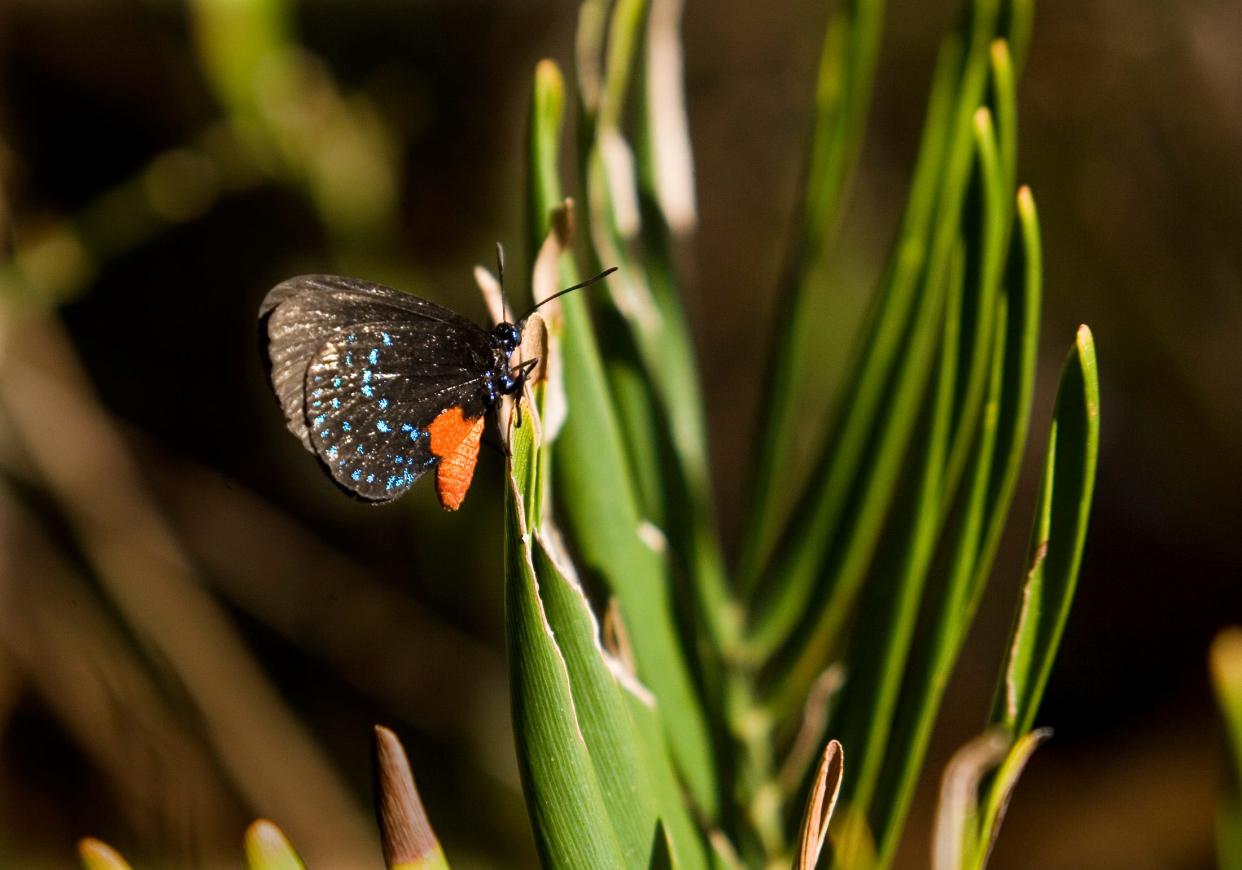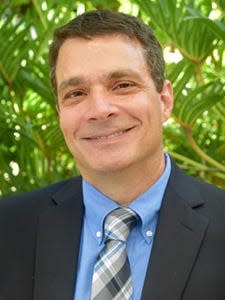Why are rare tropical butterflies making a home at USF? 'They're clearly eating something'

The University of South Florida Sarasota-Manatee campus offers the perfect habitat for professors and students. It turns out a rare tropical butterfly, whose survival as a species depends on a plant in ample supply in the campus’s landscaping, likes it here, too.
In the courtyard behind the Crosley Campus Center, between the back entrance to the rotunda and the café, visitors can see dozens of Atala butterflies – scientific name, Eumaeus atala –fluttering among the plantings, especially the coontie (Zamia integrifolia), which look like a palm or fern but are an ancient type of plant called a cycad (and may be the only thing Atala caterpillars eat). The colorful butterflies – bright red-orange abdomens and deep black wings punctuated by rows of ultramarine spots – have also been spotted among the coontie and other landscaping on the south side of Selby Auditorium.

"They're pretty striking," said Paul Kirchman, dean of the College of Arts and Sciences on the Sarasota-Manatee campus.
Kirchman, who had read about efforts to restore the population of Atalas elsewhere, may be partly responsible for what could be the first appearance of the Atala on the Sarasota-Manatee campus.
Earlier this year, Kirchman, who also teaches biology, asked campus Vice Chancellor Brett Kemker if he could plant some verbena and sweet almond to see if the flowering plants might attract Atala butterflies.
'They just showed up'
“These plants are so fragrant. It’s possible the fragrance trail attracted these butterflies,” said Kemker, who earlier in his career worked as a field biologist for the Florida Fish and Wildlife Conservation Commission.
The Sarasota-Manatee area is not part of the Atala’s historical range, which covers southeast Florida, the Bahamas and parts of the Caribbean, but Kirchman said the University of Florida Institute of Food and Agricultural Sciences has established a colony at Twin Lakes Park in south Sarasota. Kemker also has spotted the butterflies near the courthouse in downtown Bradenton.
Kirchman is less certain the plants he added to the landscaping were solely responsible for the Atala butterflies being on campus but something did bring them here, where they found the coontie, the only known host plants for Atala caterpillars and chrysalises.
“They just showed up. I don’t know if hoping for them is what made them want to come here,” Kirchman said. “They're clearly eating something, and it's not particularly the thing I planted, even if that was the thing that attracted them. They're feeding on something else.”
If you look closely on the leaves of the coontie, you might spot a multi-colored caterpillar or the next step in the insect’s life cycle, a bright orange-red chrysalis.
Once considered extinct in Florida
Coontie are “one of the few plants the caterpillars can eat,” Kirchman said. “There's a toxin in it, too, so really almost nothing else can eat it. And then the toxins keep the birds from eating the caterpillars.”
From the late 1930s until 1959, the butterflies were considered extinct in Florida, largely because of overharvesting of coontie for its starchy root, which was turned into a flour and used as an ingredient in baby food, animal crackers, beer, spaghetti and other food items.
“The coontie was harvested so heavily that it became endangered and led to the decimation of the butterfly population to the point where it was almost gone,” Kirchman said.
In the present day, coontie has made a comeback as a landscaping plant, popular in coastal Florida because it is resistant to drought, salt and the cold. It can grow in both sunlight and in the shade, making it a good choice for the Sarasota-Manatee campus and creating an opportunity for the Atala.
That the butterflies have made at least a seasonal home on the Sarasota-Manatee campus “is an indication of the health of the niche that this particular animal occupies, and it was accidentally encouraged by the landscaping of these plants,” Kemker said. “With the incredible population explosion in Florida and all the habitat destruction that is going on, we see an opportunity here on our campus where we can actually provide this butterfly a space they can thrive.”
Submitted by Marc Masferrer
This article originally appeared on Sarasota Herald-Tribune: Rare tropical butterflies making a comeback at USF Sarasota Manatee?

